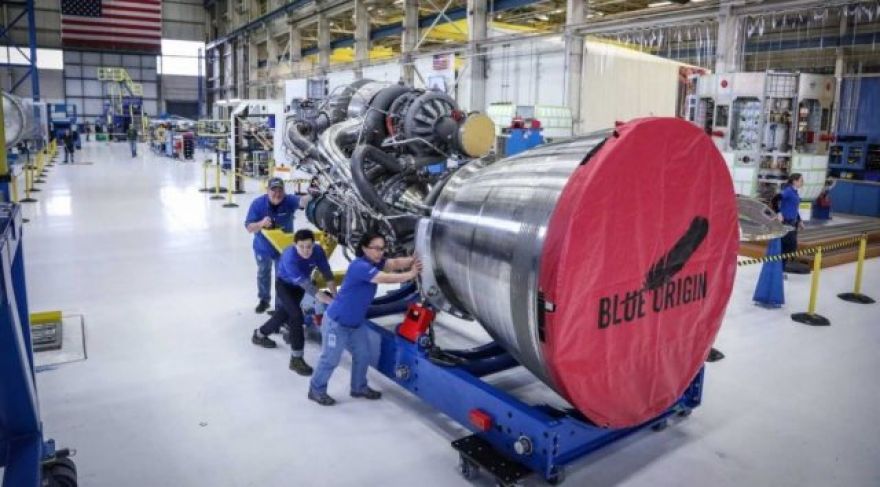
Blue Origin’s Successful Engine Test Fire Puts SpaceX on Notice
Up until now, the majority of ongoing US-based rocket coverage has focused on SpaceX. There are multiple reasons for that, ranging from the company’s groundbreaking use of reusable rockets to the simple fact that NASA doesn’t currently have a launch vehicle of its own to crow about. Companies like Jeff Bezos’ Blue Origin have rated a distant second or third, if only because they’ve been well behind SpaceX’s overall launch and deployment schedule, with seemingly little chance of catching up.
First hotfire of our BE-4 engine is a success
— Blue Origin (@blueorigin)
Blue Origin hasn’t caught up–not yet–but it did a major step forward for its own rocket engine yesterday.
The Blue Engine 4 (BE-4) has successfully completed a 3-second burn at 50 percent power. These “hot-fire” tests are a milestone for a rocket design, since they demonstrate that the rocket is capable of meeting an appreciable percentage of its rated engine output without exploding or failing in some other fashion.
The test yesterday is also a step forward for Blue Origin’s eventual deployment with the United Launch Alliance (comprised of Lockheed-Martin and Boeing). Beginning in 2002, the ULA’s Atlas V rocket (then operated solely as Lockheed-Martin) relied on a Russian-built RD-180 engine that burns kerosene and liquid oxygen for its first-stage fuel. By 2014, growing national security concerns had made this arrangement less tenable, and ULA went looking for a new partner. It found with in Bezos and Blue Origin, who signed an agreement to use the BE-4 in ULA’s upcoming Vulcan rocket.
The Vulcan Heavy configuration with all six boosters and the two BE-4 engines visible.
The BE-4 uses liquid oxygen and liquid methane for fuel and is rated for 550,000 lbf (2400 kilonewtons). ULA will deploy two engines per Vulcan, for 1.1 million lbf at sea level. That’s significantly higher than the Atlas V’s RD-180 engine, which is rated for just 860,000 lbf at sea level. Vulcan will also use up to six stretched GEM63 rocket boosters (this new variant is the GEM63XL). Each booster can provide up to 204,000 lbf; combined, the boosters offer even more thrust than the main engine. With a maximum thrust configuration of 2,324,000 lbf, the so-called Vulcan Heavy will be one of the most powerful rockets in the world when it flies (no earlier than 2019).
One of the major features of the BE-4 is its use of liquid natural gas as a fuel rather than kerosene. This allows autogenous pressurization, in which a gaseous fuel is used to pressurize a liquid fuel. LNG leaves no soot byproducts and does not require a separate pressurization system, reducing complexity and weight. In fact, while has captured the lion’s share of the attention these last few years, the company has initially relied on gradually improving rather simple rocket designs compared with the BE-4. Bezos’ baby can downthrottle as low as 20 percent , which should make landing the rocket for repeated re-use simpler and more likely to succeed.
For those of you wondering how these rockets compare to NASA’s Senate Space Launch System, the answer is a bit complicated. The SLS Block 1 will be more powerful than either the Falcon Heavy or New Glenn, with the SLS Block 1B boosting up to 105,000 kg to orbit and the SLS Block 2 nearly matching the Saturn V’s throw weight (130,000kg to 140,000kg). These estimates could change somewhat in the future if the engines are tested and found capable of boosting heavier payloads. But NASA’s ability to bring the SLS to the launchpad has been hampered by Congress’ refusal to approve budgets that would allow for realistic mission planning, or pay to keep the vehicle in regular use. That means the SLS might only fly every other year, or even less. This, in turn, drives up maintenance costs as a percentage of total vehicle cost, since there’s non-trivial expense associated with keeping up the hardware and job force required to do this work whether the rocket is flying on a regular basis or not.